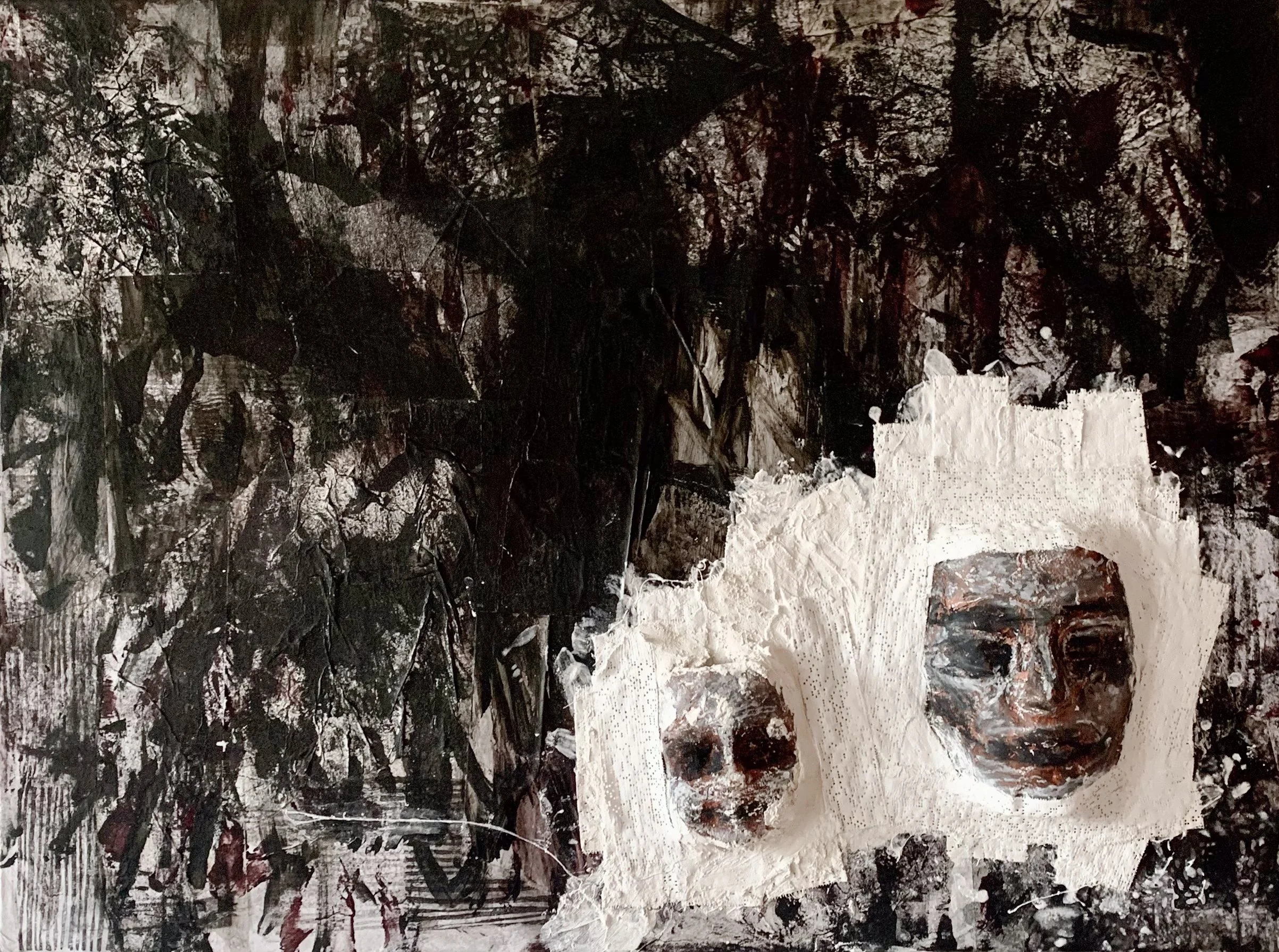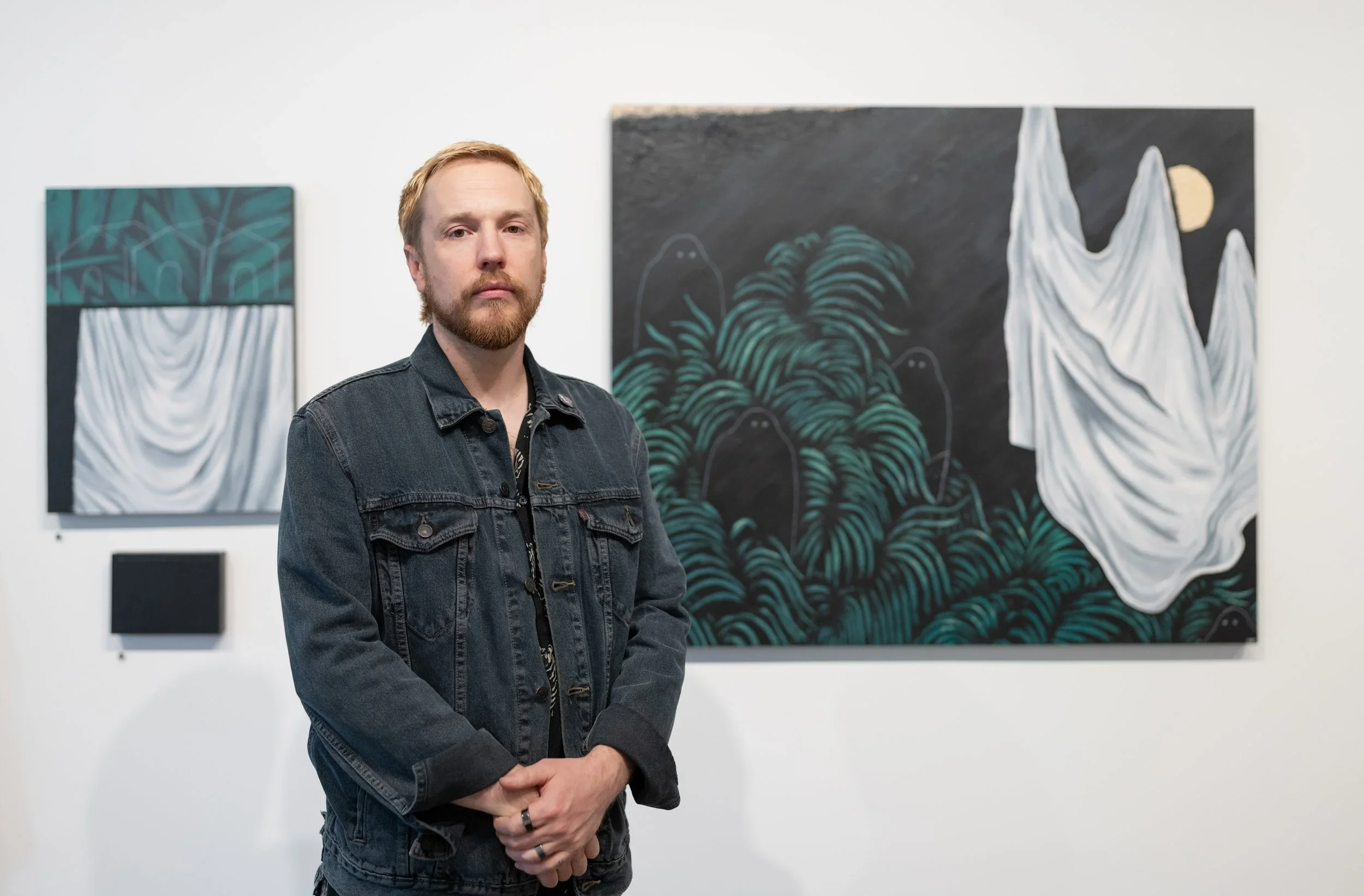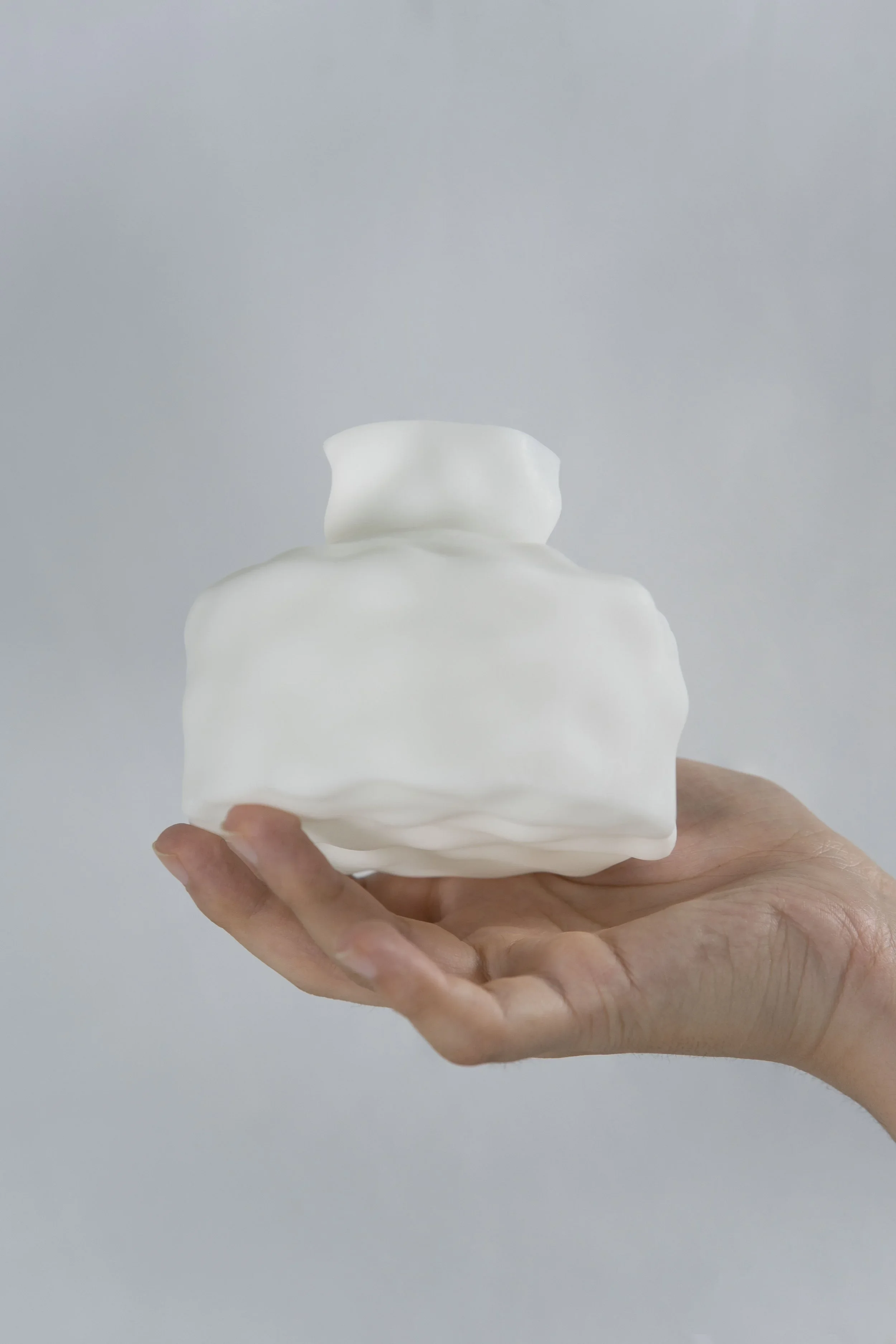10 Questions with Jace Ambwani
Al-Tiba9 Art Magazine ISSUE19 | Featured Artist
Jace Ambwani is an American artist and junior architect based in Berlin, Germany. Her early work explores themes of anonymity, familiarity, and spatial perception through painting, drawing, and printmaking. More recently, she has incorporated sculptural methods and materials to delve into themes of mortality and her evolving experiences of womanhood.
Ambwani's work has been featured in SuboArt Magazine (Issue #38), Moonday Mag (Issue #7), Visual Art Journal (Issue #31), Culterim + Cank Studio Show #4 , and the Dasein Group Show with Whatever Being Collective. She is currently preparing to relocate to London to pursue an MFA at Camberwell College of Arts in the Fall.
Jace Ambwani - Portrait
ARTIST STATEMENT
Jace Ambwani’s work is deeply informed by both her architectural training and psychological inquiry. Her background in architecture provides a structural lens through which she examines the emotional and spatial dimensions of the built environment. At the intersection of art and architecture, she frames personal and cultural narratives within physical space, blurring the lines between interior and exterior, abstract and inhabited. Yet her work moves beyond physical form.
Drawing inspiration from literature such as Sylvia Plath’s The Bell Jar, Ambwani explores the intangible landscapes of emotional and psychological experience. Recent works delve into themes of mental health, internal dissonance, and the challenge of navigating a world that often feels foreign, fragmented, and indifferent. For her, painting becomes a method of processing these tensions, transforming personal turmoil into shared visual language. A pervasive sense of disconnection runs through her practice, reflecting the tension between the search for meaning and the oppressive weight of systems that obscure or deny it.
Through both abstraction and representation, she gives form to the friction of modern life: the push and pull between progress and decay, connection and isolation, hope and despair. At its core, Ambwani’s practice is an act of bearing witness. Her paintings and sculptures are not passive reflections, but urgent inquiries. Her works invite the viewer to reconsider their surroundings and their place within them. By rendering the emotional and structural complexities of contemporary existence, she aims not only to document this moment but to challenge, provoke, and contribute to an ongoing conversation about what it means to live and to create as an artist today.
Tower Series: Landing Site, Digital Rendering, Rhino VRay Photoshop, 859x600 px, 2022 © Jace Ambwani
The Tower Series | Project Statement
The Tower Series is a collection of renderings inspired by the Great Filter theory, a concept from the Fermi Paradox. The theory posits that a formidable barrier, whether biological, technological, or otherwise, prevents intelligent civilisations from advancing to the stage of interstellar colonisation. In this project, Jace mapped seamless, generic Plattenbau facades onto alien-like vessels of her design. These vessels were then placed within imagined extraterrestrial landscapes: distant, desolate worlds where the familiar becomes unfamiliar. The result is a striking visual tension: structures that are simultaneously recognisable and alien. Tower Series is both a speculative warning and a reflection: an exploration of the emotional and existential consequences of humanity's ambition to reach beyond Earth.
Tower Series: Tower 1, 3D Model and Render made with Rhino 7, VRay, and Photoshop, 4000x2484 px, 2023 © Jace Ambwani
AL-TIBA9 ART MAGAZINE ISSUE19
Get your limited edition copy now
INTERVIEW
Your background bridges both art and architecture. How has your architectural training influenced your approach to artistic creation?
My architectural training sharpened my sensitivity to space, scale, and materiality less as technical tools and more as emotional devices. I now use those instincts across mediums: constructing immersive scenes through digital rendering, sketching initial ideas through drawing, and building physical texture with traditional fine art materials like oil pastel alongside construction-derived media such as plaster and metal mesh. For me, these materials and methods, whether digital or tactile, carry narratives of structure and erosion that feel deeply human. I use the language of building not to design spaces, but to build psychological landscapes.
Your practice spans painting, sculpture, drawing, and digital modelling. What guides your choice of medium when developing a new work? Is it the concept, the emotion, or something else entirely?
The choice of medium is almost always guided by the specific emotion or psychological impression I want to evoke. The concept dictates the feeling, and the feeling dictates the material.
Some ideas are contained and can be fully expressed within the boundaries of a painting. But when I need to elicit a more visceral reaction like a feeling of discomfort, unease, or physical intimacy, a two-dimensional surface isn't enough. That's when I move into materials that imply contact with the body: wearable sculptures, masks, or textured assemblages. The medium becomes a direct extension of the sensation I'm exploring.
Tower Series: Tower 3, Digital Rendering, Rhino VRay Photoshop, 859x600 px, 2022 © Jace Ambwani
Ultimately, what is your preferred medium, the one you would choose if you could only work with it for the rest of your practice? And how would you describe yourself as an artist?
If I had to choose one medium, it would be the convergence of the sculptural and the two-dimensional, rather than any single material. My current work exists in a hybrid space, using plaster, metal, and oil pastels to give form to internal experiences of the flesh, encompassing body trauma and mental struggle.
This is a clear evolution from my previous focus on acrylic painting, where I used architectural imagery to metaphorically explore isolation. Now, my approach is architectural in its materials. A drawing or painting becomes a base or pedestal for sculptural elements like chains, nails, and mesh. I use these materials of construction not to depict a theme, but to physically embody the feelings of psychological weight, darkness, and isolation themselves.
This synthesis is key to my identity as a mixed-media artist. I'm investigating the boundaries between structure and surface, and the physical manifestation of psychological pain. The freedom in this approach is endless, sometimes even touching on performance in how a work is revealed. So, while my specific materials might change, my core medium is this ongoing dialogue: between what is depicted and what is embodied.
Speaking of your work, you often explore themes like anonymity, alienation, and spatial perception. How have these themes evolved in your work, and what personal or external experiences have shaped this evolution?
The themes of anonymity and alienation in my work are explorations of a deep, personal uncertainty about identity, my place in the world, and what lies beyond. This exploration has evolved from suggestion to embodiment. Initially, I worked representationally, using low-polygon, familiar forms like houses or skyscrapers to evoke a hazy, universal memory of a place. The anonymity was in the generic, nowhere-quality of the environments and the figures within them.
The evolution was shaped by my need to make this internal state physically palpable. My experience with depression is not abstract; I feel it as a void within my flesh, a profound and spatial isolation. I could no longer just depict this from a distance. I had to make it a space one could almost step into.
This led me to break down my own visual language to its fundamental parts. I began constructing environments using raw, structural materials that carry their own narrative of construction and erosion. The goal is to trigger that same sense of a hazy memory, but now through texture and physical presence, to evoke a profound sense of discomfort and unease in the viewer.
Self Portrait, Plaster and Oil Pastel, 7x10 cm, 2025 © Jace Ambwani
Untitled, Mixed Media and Plaster on Canvas, 70x50 cm, 2025 © Jace Ambwani
The Tower Series is visually striking and conceptually rich, drawing on the Great Filter theory. What drew you to this particular concept from the Fermi Paradox, and how did you begin translating it into visual form?
The Fermi Paradox, and specifically the Great Filter theory, has long fascinated me: the idea that some unknowable barrier prevents civilisations from progressing interstellar. I'm drawn to its grim relevance today, as we accelerate into AI and space exploration. It forces us to confront not just can we, but should we?
Tower Series visualises the moment an astronaut, utterly alone, discovers alien ruins, proof that a great filter lies ahead, and humanity is doomed. I wanted to capture that visceral solitude: the weight of knowing, with no one to tell. Initially, I depicted these as derelict architecture, fallen towers, dilapidated blocks, but today I'd reimagine them as abandoned data centres. Empty server racks and silent AI would serve as a more potent metaphor: not just ruins of life, but ruins of intelligence itself.
Can you walk us through your creative process for this series, from initial idea to the outcome? Where did you draw inspiration from, and how did you come up with such a striking series?
Tower Series began as my final project for an Advanced Digital Media class, where we focused on SubD modelling in Rhino, texture design, computational design, and photorealistic rendering. For the final project, we were simply asked to make something using all the tools we had learned that semester. I wanted to visualise the moment that theory becomes devastatingly real: an astronaut discovering alien ruins, meaning the Filter is still ahead of us, and humanity is doomed.
I started with sketches and material studies, aiming to create a seamless, atmospheric environment that felt both ancient and eerily familiar. I modelled derelict apartment-block spaceships meant to evoke collective living, now abandoned to symbolise a fallen civilisation. A crucial part of the process was composing the renders themselves and finding camera angles that emphasised the oppressive scale of the ruins, using low vantage points and vast shadows to make the structures feel overwhelmingly large and the figure small and isolated. This reinforced the feeling of existential doom: that piercing realisation with no one to report back to. The project remains a foundational exploration for me, merging digital world-building with deep existential questions.
Cliffs, Rice Paper, Block Ink, Acrylic Paint, and Oil Pastel on Canvas, 18x36 cm, 2025 © Jace Ambwani
From your experience living and creating in Berlin, how has the city's architectural and cultural landscape informed your work? Are there specific spaces or atmospheres that have inspired you?
Living in Berlin has deeply shaped my practice. The city is a living document of layered history, where the stark architecture of competing ideologies creates a potent, heavy atmosphere. What truly inspires me, however, is the city's cultural response to that weight. Berlin's spirit is found in its counter-culture: artists, punks, and rebels who reclaim spaces. They don't just live with history; they dialogue with and subvert it through graffiti, community projects like Holzmarkt, and techno clubs in industrial ruins.
I'm drawn to this resourcefulness: the pop-up gallery in an empty apartment, community gardens at Tempelhofer Feld. Witnessing this has reshaped my relationship to materials. The cracked plaster on a facade, rusted steel, and construction site mesh. These are more than textures to me now; they form the city's visual language. My work has become an effort to translate that language, using these materials of decay and rebirth to explore my own psychological landscapes.
There's a recurring interest in solitude and existential disquiet in your practice, often amplified by scale and space. How do you think your work impacts viewers emotionally or psychologically? What kind of dialogue do you hope to initiate?
I hope the work evokes a subtle but potent discomfort: not perverse, but existential. It's that feeling of being alone in a quiet, vast space, which can be both unsettling and strangely peaceful.
The anonymous figure acts as an anchor of scale, but also as a mirror: it could be me, my neighbour, or the viewer themselves. This anonymity is intentional: it's a vessel for shared experience. The elongated shadows, often cast during the liminal hours of dawn or dusk, symbolise the passage of time and amplify the sense of isolation. These are the hours of reflection, even overthinking; the hours that feel most existential.
The dialogue I want to initiate isn't verbal, but emotional. I'm interested in creating a silent space where viewers confront their own relationship to solitude, scale, and the passage of time to see their own quiet disquiet reflected back at them.
Experimental Light and Shadow, Acrylic Paint and Oil Pastel on Canvas, 30x50 cm, 2024 © Jace Ambwani
Human Suburbs 1, Acrylic Paint on Canvas, 50x70 cm, 2024 © Jace Ambwani
You're about to begin your MFA at Camberwell College of Arts. What are you hoping to explore or challenge in your practice during this next chapter in London?
A change of scenery always fuels my creativity, and I'm looking forward to how London will influence my work. Since being accepted into Camberwell, my practice has evolved significantly, it's become more personal and materially explorative. I'm excited to deepen this direction using the college's resources and to further develop my artistic voice within a critical yet supportive academic environment. Most of all, I value having dedicated time and space to focus fully on expanding my practice.
Lastly, looking ahead, are there any themes, technologies, or mediums you're excited to explore in future projects? How do you envision your practice evolving over the next few years?
Right now, my focus is on the materials in front of me. I'm committed to seeing how far I can push them. In the near future, I want to introduce even rawer elements, such as unprimed canvas and natural pigments, to deepen the material tension in my work.
I also plan to move beyond the wall. I'm beginning to think about how these materials can be used in costume, and how costume can activate performance and film. The bigger picture is building environments. I want to use these combined elements to create fully immersive, physical experiences that are felt as much as they are seen.
Artist’s Talk
Al-Tiba9 Interviews is a curated promotional platform that offers artists the opportunity to articulate their vision and engage with our diverse international readership through insightful, published dialogues. Conducted by Mohamed Benhadj, founder and curator of Al-Tiba9, these interviews spotlight the artists’ creative journeys and introduce their work to the global contemporary art scene.
Through our extensive network of museums, galleries, art professionals, collectors, and art enthusiasts worldwide, Al-Tiba9 Interviews provides a meaningful stage for artists to expand their reach and strengthen their presence in the international art discourse.


























